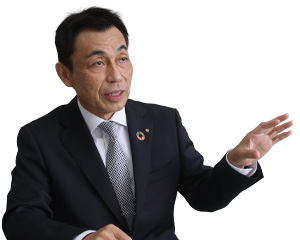


The Sixth Assessment Report of the Intergovernmental Panel on Climate Change (IPCC), published in August 2021, states that there is no longer any doubt that global warming is affected by human activities. The damage caused by abnormal weather, such as the torrential rains and forest fires that are occurring frequently in all parts of the world, is enormous. The climate change problem is a real and urgent threat created by humans. Global warming is not simply climate change; it also bears strongly on resource recycling, water risks and biodiversity, and multifaceted efforts to combat it are important.
In 2016, the Toyoda Gosei Group formulated the TG 2050 Environmental Challenge, which targets zero plant CO2, to do our part in overcoming this crisis. We also established the Targets 50&50, our medium-term targets for 2030, for the early realization of carbon neutrality and a circular economy, and have initiated company-wide, cross-sectional projects and are accelerating efforts integrated into company activities.
The entire Toyoda Gosei Group will continue to do its utmost to contribute to protecting the global environment, under the slogan “A Greener, Richer World for Our Children.”
Contributing to environmental preservation through all our business activities

Basic philosophy
The Toyoda Gosei Group formulated its 1st Environmental Action Plan in 1993 based on its environmental policy, and since that time has been actively confronting environmental issues. In February 2016, we announced our TG 2050 Environmental Challenge, and have set targets to be reached by 2030 as milestones. We have also formulated a 5-year action plan in which activity items and targets are set and are carrying out activities to protect the environment.
Globally, we have placed integrated environmental functions in the regions of the Americas, China, ASEAN, and India. The Group is also making efforts as a whole with area control in five global regions, the above four plus Europe/South Africa. These efforts are made in conjunction with government agencies, customers and suppliers.
1.Environmentally-friendly corporate activities
We are keenly aware that all stages of our business relate deeply to the environment, from development, production, and sales activities to end-of-life disposal. The Toyoda Gosei Group, including all internal departments, domestic and international affiliates, and suppliers, conducts all business activities with concern for the environment in cooperation and coordination with customers, government authorities, and others.
2.Good corporate citizenship
As a good corporate citizen, we participate in, support, and cooperate with environmental activities by many groups while also working on environmental activities in the community and broader society. We also provide education for all employees to support them in becoming involved in environmental activities as members of the community and society, and support social contributions and volunteerism.
3.While spreading information on these activities, we listen to the opinions of people at all levels of society and work to improve our activities wherever we can.
TG 2050 Environmental Challenge — A Greener, Richer World for Our Children
The Toyoda Gosei Group specializes in the field of high polymersーrubber and plastics. Our symbol is the benzene ring, a hexagonal hydrocarbon structure that is the starting point for polymers. Borrowing from the six sides of the benzene ring, the TG 2050 Environmental Challenge sets six challenges to strengthen our environmental efforts with a long-term view to the year 2050. As a roadmap to achieve that, we have set targets for 2030 (Targets 50&50) as milestones and formulated a five-year Environmental Action Plan to guide our efforts.
TG 2050 Environmental Challenge (Six Challenges)
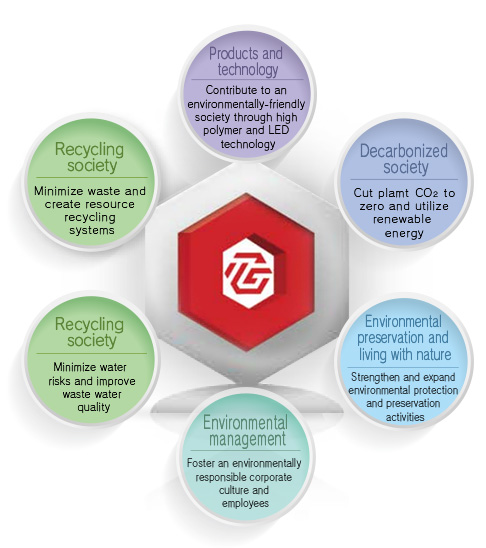
Medium- and long-term scenario for achieving carbon neutrality
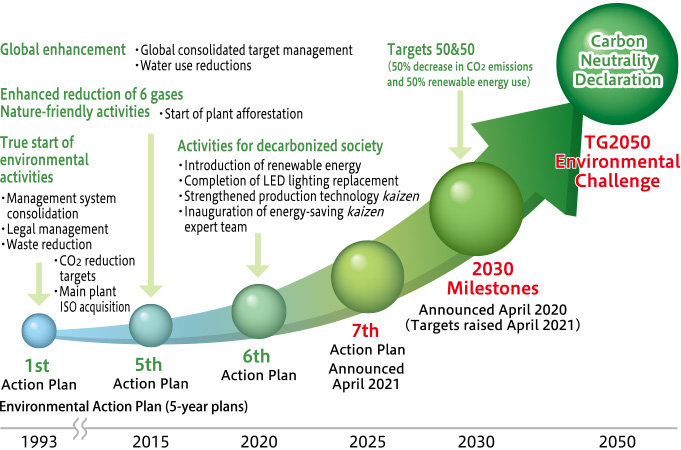
Support for TCFD recommendations
The Toyoda Gosei Group endorsed the recommendations of the Task Force on Climate-related Financial Disclosures (TCFD) in May 2019, and has analyzed risk/opportunity scenarios and response scenarios based on guidelines. Together with an acceleration of efforts, including the TG 2050 Environmental Challenge and review of our 2030 milestones, we are actively disclosing relevant information.
Click here for results of scenario analysis
Efforts to date
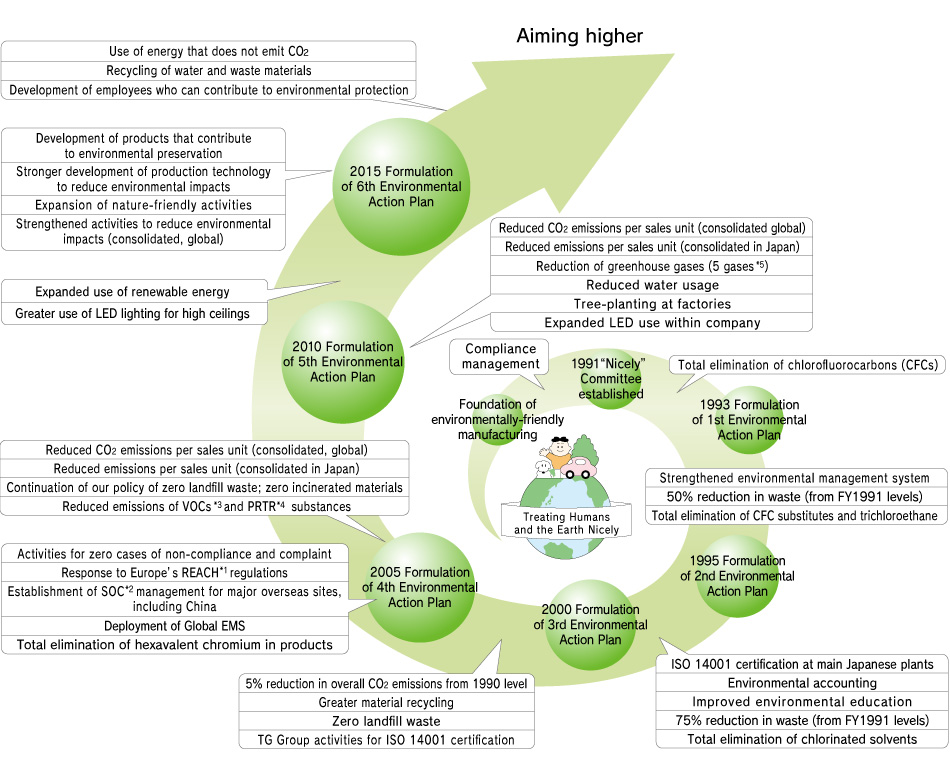
- *1 Registration, Evaluation, Authorization and Restriction of Chemicals
- *2 Substances of Concern
- *3 Volatile organic compounds
- *4 Pollutant Release and Transfer Register
- *5 Hydrofluorocarbons (HFC), perfluorocarbons (PFC), sulfur hexafluoride (SF6), methane (CH4), nitrous oxide (N2O)
Environmental organization
Our medium- and long-term policy and key action items are discussed and decided in a Carbon Neutrality and Environmental Committee chaired by the company president. The Carbon Neutrality and Environmental Committee consists of three subcommittees in the areas of products, production, and quality. In the area of production, a production and environment subgroup has been established to strengthen environmental activities over the entire manufacturing process. The above subcommittees are further broken down into working groups that promote and manage areas such as reductions in energy use, waste products, and volatile organic compound (VOC) emissions, and preservation of the environment. In this way, environmental preservation and management activities are conducted from an expert perspective.
A carbon neutrality project was started in FY2021 to accelerate efforts over the product lifecycle. The project is headed by the president and with outside directors as advisors and the general managers of related divisions as members.
■Environmental organizational structure

Carbon Neutrality Project
【Structure】The project is headed by the President and has Chiefs of the Corporate Strategy Headquarters, Research and Development Headquarters, and Automotive Business Headquarters serving as project leaders. The core members are division general managers and above. This structure allows for quick decisions and actions in management issues.
【Activities】Each task is carried out with the relevant division general manager as leader.
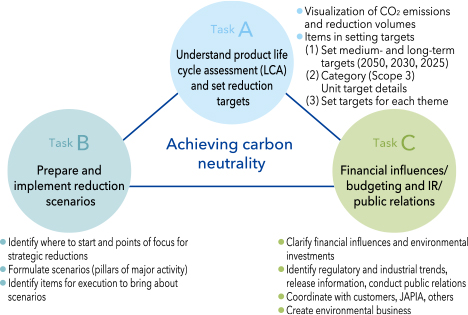
Risk and opportunity associated with climate change and resource depletion
The risks and opportunities associated with climate change and resource depletion are recognized as an important management issue. From a global perspective based on laws, regulations and trends, we are strengthening our responses to the overall financial and social risks from the effects on economic and production activities of more drastic abnormal weather, changing precipitation patterns, droughts and floods.
| Risk | Opportunity | |
|---|---|---|
| Climate change | ||
| Resource recycling | Effects of water shortages and floods on production activities | Cost reductions from re-use and decreased use of water |
| Cost increases from difficulty in procuring materials, soaring material prices | Cost reductions from recycling technology, use of fewer materials | |
| Management (regulatory compliance) | Loss of trust in the company due to environmental problems, including legal violations, and insufficient efforts to protect the environment | Increase in brand strength from enhanced environmental activities |
| Biodiversity |
|
|
Resource utilization and environmental emissions in business activities
To lessen the amount of energy, material and other resource inputs, and maximum product output, we are utilizing our skills in product development, process development and workplace kaizen in efforts to improve through business activities.
The input resources we use include environmentally friendly materials and clean energy.
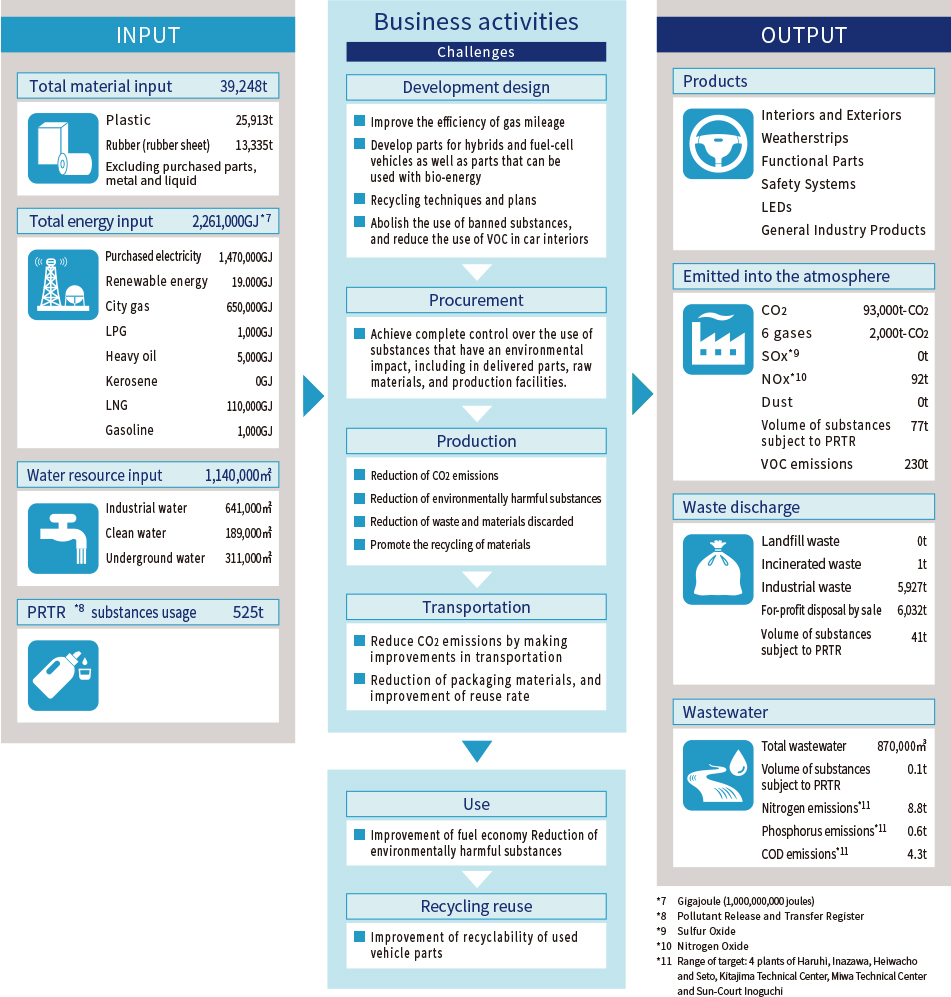
Environmental impact in the value chain
From the perspective of preserving the earth, we have surveyed and disclosed not only GHG emissions (Scope 1*12, Scope 2*13 ) in our business activities but also emissions in our entire value chain including excavation of raw materials and product use and disposal (Scope 3*14 ). Our Carbon Neutrality Project was inaugurated in FY2021 to improve accuracy of Scope 3. Together with this, we have established milestones and created scenarios for carbon neutrality.
- *12 Greenhouse gas emissions emitted directly by the company itself (natural gas and other fossil fuels, etc.)
- *13 Indirectly emitted greenhouse gases (electricity, etc.)
- *14 Greenhouse gases emitted in the supply chain that are indirectly emitted by the company (manufacturing, transport, business travel, commuting, etc.)
■CO2 emissions by scope level
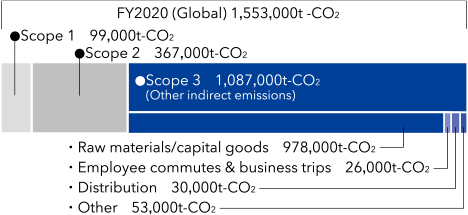
Environmental Protection Costs
Toyoda Gosei accurately monitors costs incurred for environmental protection in our business endeavors, and conducts appropriate environmental protection activities.
In Toyoda Gosei’s FY2020 environmental protection costs, priority is placed on research and development, business areas (switch to LEDs for high-ceiling lighting, recycling, greenhouse gas reductions), and social activities (Plant Afforestation). The economic effects include reduced waste disposal costs with measures to reduce waste production and increase waste recycling, thorough daily kaizen in workplaces, and lower electricity costs with increased efficiency in utility equipment.
■Environmental Protection Costs
(Unit: \100 million)
| Type of cost | Toyoda Gosei | Affiliates in Japan, total |
|---|---|---|
| Research and development costs*15 | 12.8 | 0 |
| Costs within business areas*16 | 25.3 | 3.8 |
| Management activity costs*17 | 2.4 | 0.3 |
| Social activity costs*18 | 2.1 | 0.1 |
| Environmental damage costs*19 | 0.1 | 0 |
| Total | 42.7 | 4.2 |
- *15 Costs for research and development of products that reduce environmental impact
- *16 Costs to reduce environmental impacts from production, including pollution control, reduced energy consumption, and waste disposal.
- *17 Costs for management, including education, maintenance of the environmental management system, and measurements.
- *18 Costs for such measures as tree-planting and beautification.
- *19 Costs for dealing with environmental impacts from business operations.
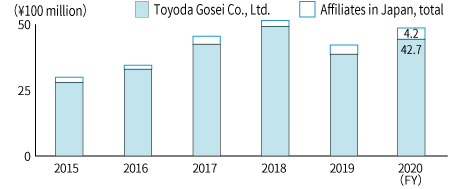
■Economic effect*20
(Unit: \100 million)
| Item | Toyoda Gosei | Affiliates in Japan, total |
|---|---|---|
| Energy expenses | 3.7 | 0.5 |
| Waste-processing expenses | 1.3 | 0.1 |
| Total | 5.0 | 0.6 |
- *20 The economic effects calculated here are those that can be ascertained based on solid evidence.
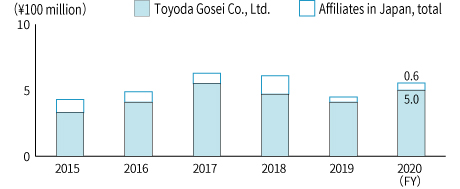
■Quantitative effect*21
| Item | Effect |
|---|---|
| Global warming prevention (CO2 reduction) | 13,019t-CO2 |
| Waste reductions (amount reduced) | 627t |
| Legal compliance |
- *21 Amounts are calculated for Toyoda Gosei alone.
Environmental Data
- Contributing to Environmental Preservation Through All Our Business Activities
- Environmental Action Plan
- Building a Decarbonized Society
- Building a Recycling Society
- Environmental Preservation and Building Environmentally-Friendly Societies
- Environmental Management
- Collaboration with External Organizations
- Environmental Efforts at Affiliated Companies
- Environmental Data
- Third-Party Verification
- TCFD
- Third-Party Assessment